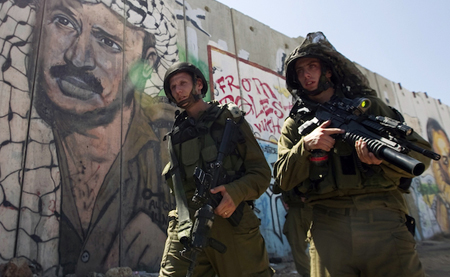Anger Management
A new book finds fault with Israel’s anti-terror tactics
Tibor Krausz
The Jerusalem Report, July 6, 2009
In its fight against terror Israel has always faced a Sisyphean struggle of Whack-A-Mole. No sooner has it eliminated a terrorist group or short-circuited a terrorist tactic than another group or tactic has popped in its place. In the 1970s, beefed-up security put paid to endemic airline hijackings (inaugurated in 1968 by Palestinian terrorists on an El Al plane bound from Rome). Militants responded by ceaselessly infiltrating northern Israel from southern Lebanon’s “Fatahland” to massacre civilians and engage in bloody hostage takings.

Israel’s punitive invasion of Lebanon in 1982 put an end to that, too. Before long, though, Fatah was replaced by Hezbollah as well as a sinister new terror technique — suicide bombing. Success leads to imitation and Palestinians were soon “martyring” themselves in copycat attacks. And so it goes. Israel clamps down on terror networks at home. Radicals go after Jewish targets abroad. Israel fortifies itself against incessant suicide attacks by sealing off the West Bank and Gaza. Terrorists start lobbing missiles.
By its very nature, terrorism is resilient. As Israel has learned from bitter experience, foiling terror attacks or dismantling terror networks is one thing; eradicating terrorism is another. Boasting of terrorism’s operational advantages, the IRA famously warned Margaret Thatcher after a failed attempt on her life in 1984: “Today we were unlucky, but remember we only have to be lucky once; you will have to be lucky always.”
If Israel hasn’t always been lucky, it hasn’t been for want of trying. As Ami Pedahzur, an Israeli terrorism expert at the University of Texas in Austin, details in his new book “The Israeli Secret Services and the Struggle Against Terrorism,” the Jewish state’s secret agents, spies and warriors have gone after Arab terrorists with a vengeance. Besides perfecting the time-honored practices of surveillance, subterfuge and sabotage, they didn’t shy away from repaying terrorists in kind through retaliatory attacks, assassinations, reciprocal abductions and the occasional extrajudicial killings of terrorists already in custody (to domestic outrage).
Have such methods worked? Not too well, in Pedahzur’s view. Although military and clandestine operations have saved countless lives by thwarting Arab terrorists, this “war model” (pioneered by Ariel Sharon in the 1950s) has hardly been an unqualified success, he insists. “Unlike military struggles,” Pedahzur notes, “the lack of symmetry between the state and the terrorists often works in favor of the latter.”
That’s not least, we might add, because whereas Israel is expected to adhere to moral and legal principles in its fight against terror — and is roundly excoriated for perceived violations often labeled as “war crimes” — terrorists need have no such scruples. International media coverage is also stacked heavily against Israel.
* * *
Modern intelligence gathering by Jewish security services during the British Mandate, Pedahzur explains, was born of failure. With its cells acting independently and in competition, Sherut Yediot (“Intelligence Service”) — Shai for short as the makeshift precursor to the Israeli domestic security agency Shin Bet — failed to anticipate the Arab revolt of 1936 by underestimating the extent of simmering Arab resentment against Jewish immigrants.
Humbled Jewish agents, mostly farmers who lived near Arab communities, regrouped under the aegis of the Shai Arab Department headed by Ezra Danin, a citrus grower. Intelligence gathering was centralized at a bona fide spy agency, whose headquarters on Ben Yehuda Street in Tel Aviv was disguised as a “Consulting Office.” Besides keeping tabs on Arab troublemakers and Jewish collaborators in British employ, Shai agents deciphered encrypted British military communications and intercepted exchanges between foreign and local Arab forces. Meticulous intelligence enabled the Palmach’s crack commandoes to foil several potentially devastating Arab guerrilla attacks against the budding Jewish State at strategic locations in Jerusalem and Tel Aviv.
After Israel’s independence in 1948, the IDF picked up where the Palmach had left off. In response to intensifying cross-border attacks by Arab militias, a young Ariel Sharon and his Dirty Dozen type of handpicked commandoes in Unit 101, a new elite counterterrorism force, embarked on revenge attacks against the fedayeen, often striking inside Egypt and Jordan under cover of night. Although it ushered in subsequent IDF practice, Sharon’s unit was soon disbanded after a retaliatory raid for the murder of an Israeli mother and her two children in 1953 left scores of West Bank villagers dead.

Faced by unrelenting terror attacks, Israel also began targeting militants for assassination. Yet these tit-for-tat killings, Pedahzur argues, were often motivated as much by revenge as by legitimate operational objectives, and he reminds us that such assassinations invariably elicited violent responses. Surely, though, something needed to be done about terrorists who, when caught, were promptly sprung from European jails following demands by their hostage-taking comrades — if they weren’t already living the high life of “heroes” with ostentatious impunity in Middle Eastern safe havens. Admittedly, assassinations could go wrong: a Moroccan waiter in Lillehammer was gunned down in 1973 by Mossad agents who amateurishly mistook him for the mastermind of the 1972 Munich Olympics massacre of Israeli athletes. Botched attempts weren’t uncommon, either — notably the abortive poisoning of Hamas political head Khaled Mashal in Jordan in 1997, which led to an international fiasco for Israel and left the Mossad with egg on its face.
In recounting such landmarks from the murky world of Israeli counterterrorism operations, Pedahzur often makes short shrift of context, so that his account reads like a string of Wikipedia entries. He clearly disapproves of the Mossad’s less than stellar performance in its Operation Wrath of God intended to hunt down those responsible for Munich. Yet nowhere do we learn of the agency’s success in preventing the same terrorists from assassinating Golda Meir during her visit to the Vatican the following year. It was thanks both to old-fashioned surveillance and to an alert Israeli agent who rammed and capsized a suspicious-looking van with three terrorists inside armed with rocket launchers as they were waiting at Rome’s Fiumicino Airport for Meir’s plane.
* * *
Prior to the signing of the Oslo Accords in 1993, covert Israeli agents, acting through a bogus furniture-import business with the PLO’s security chief, installed an orthopedic chair and a designer lamp, both bugged, in the offices of Mahmoud Abbas in Tunis. Undercover operatives had also successfully penetrated Palestinian militant cells during the Intifada: members of an embedded antiterrorism unit even showed up in newspaper photos of “Palestinian youths” pelting IDF vehicles with stones.

Such tidbits alone make Pedahzur’s concise account worth reading. For a work of scholarship, however, his slim volume comes up short on analysis. While he often portrays Israeli security services as brash and belligerent, we search in vain for insight into the formidable challenges they face daily. Security services have limited resources and in establishing priorities they must take calculated risks. Pedahzur also bemoans Israel’s trademark “war model,” which he insists “leads to an escalating cycle of terrorism.” He advocates focusing instead on the “defensive” and “conciliatory” approaches, the former along the lines of the new security fence. Be that as it may, neither approach is likely to see off Islamist terrorism, perennially stoked as it is by deep-seated hatreds and artificially generated “grievances” that further Israeli concessions alone won’t eradicate. As Ehud Barak learned at Camp David in 2000, extending a hand in peace to someone who doesn’t wish to take it makes for a poor policy initiative. Likewise, Israel’s unilateral withdrawal from Gaza exacerbated matters, rather than improve them.
Pedahzur contends that most acts of terror don’t pose “a major threat to the national security of a country” -- which may not be immediately obvious in the case of a tiny nation like Israel denied the very “right to exist” by enemies hell-bent on acquiring weapons of mass destruction. He’s right to point out, however, that some of Israel’s current predicament may well have been self-inflicted. It certainly hasn’t helped matters, as Pedahzur explains, that the country’s three main security agencies — the Shin Bet (or General Security Service) in charge of operations in Israel and the Territories; the Mossad, operating globally; and Aman (the IDF Intelligence Branch) — have been riven by petty rivalries and infighting. Encroaching on each other’s turfs, they have at times worked at cross purposes — often with dire consequences.
In the early 1990s, for instance, when Hezbollah set about garnering grassroots support among war-weary Lebanese through new welfare services, the Shin Bet urged countering the terrorist group by launching similar populist policies via Israel’s local allies. Aman, however, convinced then defense minister Moshe Arens to nix the idea, insisting that “Hezbollah did not have a real hold on the population, making the initiative unnecessary.” Arens probably didn’t need much convincing as he later admitted having seen the rise of Islamists as “a healthy phenomenon.”
Nor was the Israeli intelligence community more prescient in its initial dealings with Hamas. Groomed by the Shin Bet in the late 1980s as an ostensibly apolitical counterweight to the PLO, the Palestinian offshoot of the Egyptian Muslim Brothers would soon metamorphose into an even more implacable foe than Fatah. During the First Intifada (1987-1993), Hamas was allowed to slip under the radar until, aided by Hezbollah, it began launching its own brand of terror, including suicide bombings. Between 2000 and 2004 alone, the 157 suicide attacks claimed 507 Israeli lives, amounting to half the lives lost in a staggering total of 36,000 terror attacks. Suicide bombings are up to six times more lethal than traditional shootings and grenade attacks, experts say. In addition, mounting a suicide mission costs pennies and requires much less logistical planning as there’s no need for escape routes.
Meanwhile, lack of adequate training to shifting terrorist tactics and alternative scenarios could place even battle-hardened Israeli units in harm’s way while simultaneously compromising their effectiveness. Elite Shayetet 13 (Flotilla 13) naval commandoes, a formidable force at sea, might find themselves out of their depth, Pedahzur says, when redeployed for guerilla-style warfare in the dense hostile urban jungles of the West Bank. Internecine rivalry could also lead to tragicomic situations, such as when in April 2002 elite commandoes eager to be assigned to the high-profile capture of Fatah leader Marwan Barghouti hoped to prevent a rival unit from participating by spiriting away its transport vehicle.
To forestall such niggling squabbles while also countering threats more effectively, Pedahzur recommends the creation of a central intelligence brain trust based on the US model. Whatever the merits of this proposal, which isn’t fleshed out in detail, his book can serve as a valuable refresher on the enduring legacy of terrorism against beleaguered Israelis. We’re reminded, for instance, that on May 13, 1974, three stalwarts of the Democratic Front for the Liberation of Palestine from Lebanon crept into the town of Ma’alot in northern Israel where they took over a hundred high-school students hostage, later massacring 18 of them in an orgy of gunfire and grenades.
In fact, there hasn’t been a single year in Israel’s 61-year history without casualties to terror, usually in the dozens, sometimes in the hundreds. (And that’s not counting Jews murdered abroad.) In 2002 alone, at the height of the Second Intifada, 451 Israelis died and over 2,300 others were maimed in terror attacks. You’d be hard-pressed to find mention of the vast historical scope of Arab terrorism against the Jewish State behind the ephemeral headlines about the stalled “peace process” allegedly in limbo because of Israel’s intransigence in failing once more to accommodate Arab demands.
Technological advances have given greater potential for terrorists to wreak havoc. Israel’s security services are also facing unprecedented logistical challenges as Islamic terrorism is outsourced globally to newly radicalized groups of Muslims outside the Middle East, especially Pakistanis. “[T]he increase in Islamic immigration to the West has now created a situation,” as Pedahzur puts it, “in which almost every major city in Europe, America and Australia has a widespread network of mosques, as well as Islamic education and welfare institutions.” And if there’s one thing that unites Islam’s warring factions, it’s their hatred of Jews and Israel.
Meanwhile, threats faced by Israel are undergoing yet another mutation. While waging a war of attrition against the “Zionist entity” through its proxies Hamas and Hezbollah, Iran is spoiling to take terrorism to the next level by acquiring nuclear weapons. If history is any guide, Israeli security services will have their hands full for many years to come.